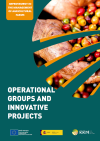Media library
Documentary, graphic and/or audiovisual knowledge objects are offered here, offering information on various sectors and topics. Use the keyword search or search filters to access current audiovisual and documentary knowledge objects useful for your implementation.
If you have any questions or suggestions, please contact us here.
Guidelines for the biological control of the chestnut wasp
Recommendations for the release of Torymus sinensis, a biological control organism for the chestnut wasp
Technical information on the apple snail pest in rice
The Pomacea insularum (apple snail) species is found in Spain. First detected in 2009, it has spread throughout the Ebro Delta. This species is considered one of the 100 most harmful invasive species.
Almond wasp
The almond wasp (Eurytoma amigdali E) is a hymenopteran recently discovered in almond orchards in the Valencian Community. The adults are black and emerge in spring from the fruit they parasitized the previous season.
National contingency plan Pomacea maculata (= P. insularum) (apple snail)
This document sets out the measures to be taken against gastropod mollusc species of the genus Pomacea, a quarantine pest in Europe, with the aim of preventing their appearance and, if they do appear, acting quickly and effectively, determining their distribution and combating them with the aim of eradicating them.
Phytosanitary bulletin of notices and information
Pollinating insects are vitally important for the proper functioning of crops. Pollination is essential to ensuring the quantity and quality of crops and food production, directly linking wild ecosystems with agricultural production systems.
Plant health, pest sheets: Mhytimna unipuncta
Mhytimna unipuncta is a defoliating caterpillar of meadows and corn, which causes damage of varying intensity, although it is increasingly common in Cantabria and in certain areas can cause some alarm among the population.
“Xylella fastidiosa Conference.” Diseases caused by Xylella fastidiosa and its status worldwide.
On February 12, 2019, a "Seminar on Xylella fastidiosa" was held in the Assembly Hall of the Ministry of Agriculture, Fisheries, and Food. This seminar is part of the measures adopted by the Ministry to disseminate information and raise awareness about the fight against and control of Xylella fastidiosa.
Poster on Xylella fastidiosa in the Balearic Islands
Xylella fastidiosa (Wells et al.) is a quarantine phytopathogenic bacterium that has a very wide range of host plants (more than 300 plant species), and can cause serious damage to the most important crops of the Balearic Islands, such as almond, vine, olive, citrus or fig trees, and to numerous species of ornamental plants (rosemary, lavender, polygala and acacia, among others).
Xylella fastidiosa. Vector population behavior.
Xylella fastidiosa is a bacterium that lives in the xylem of plants, preventing the normal flow of water and nutrients. It causes diseases in various economically important crops, depending on the subspecies and genetic group of the bacteria. The most characteristic symptoms are the scorched appearance of leaves and shoots.
Xylella fastidiosa contingency plan, national program for the implementation of phytosanitary regulations.
This document sets out the measures to be taken against the bacterium Xylella fastidiosa, a priority Union quarantine pest, with the aim of preventing its emergence and, if it does appear, acting quickly and effectively, determining its distribution and implementing eradication measures.
Spodoptera frugiperda Contingency Plan (Smith)
This document sets out the measures to be taken against the fall armyworm, Spodoptera frugiperda (Smith), a priority pest (according to Delegated Regulation (EU) 2019/1702) regulated in the European Union (EU) by Regulation (EU) 2016/2031, Regulation (EU) 2019/2072 and Implementing Decision 2018/638 (EU), with the aim of preventing its appearance, and in the event that it appears, acting quickl
Thaumatotibia leucotreta (Meyrik) Contingency Plan
This document sets out the measures to be adopted against Thaumatotibia leucotreta (codling moth), a pest regulated by the EU as a priority quarantine pest under Implementing Regulation (EU) 2019/2072 and Delegated Regulation (EU) 2019/170.
Popillia japonica (Newman) Contingency Plan
This document sets out the measures to be taken against the Popillia japonica (Newman) insect, a quarantine pest, with the aim of preventing its appearance, and if it does appear, acting quickly and effectively, determining its distribution and combating it in order to try to eradicate it and at all times prevent its spread.
Phytosanitary alert and information network, field protocol for crop monitoring: winter cereals
Field manual for estimating the risk of damage caused by pests and diseases in winter cereal crops.
Phytosanitary alert and information network, field protocol for crop monitoring: rice
Field manual for estimating the risk of damage caused by pests and diseases in rice crops.
Phytosanitary alert and information network, field protocol for crop monitoring: almond
Field manual for estimating the risk of damage caused by pests and diseases in almond cultivation.
Phytosanitary alert and information network, field protocol for crop monitoring: cotton
Field manual for estimating the risk of damage caused by pests and diseases in cotton crops.
Manual of good practices for cereal production
The aim of the Handbook is to contribute to improving farmers' economies, increasing the sustainability of cereal production and combating climate change by adopting innovations developed through training for all actors in the cereal chain and society in general.

Improvement In The Management Of Agricultural Farms. Operational Groups And Innovative Projects
English translation of a compilation of projects developed through Rural Development Programmes, operational groups and innovative projects that are working on issues of improvement in the management of agricultural holdings.



